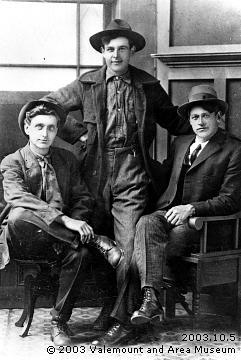Flows SE into Canoe River, SW of Valemount
52.7444 N 119.0972 W — Map 83D/11 — Google — GeoHack
Earliest known reference to this name is 1913
Name officially adopted in 1934
Official in BC – Canada

Everett Bogardus, Phil Estwein and Dave Henry, about 1914
Valemount and Area Museum
Dave Henry first visited the Valemount area before 1910. “He and Fulton McKirdy came up the Canoe Valley in a scow from Revelstoke as far as they could,” said Mike Frye, whose family accompanied Henry to the area from North Dakota in 1911. Henry was “one of the best liked in the district, a real story teller,” according to another early settler. He was nicknamed “the Grizzly” because of his hair.
Henry opened the first store at Swift Creek (later named Valemount) in 1912. He is listed as storekeeper in the 1937 Valemount voters’ list, and as a cook in the 1943 Valemount post office directory. He was trail cook for the Hargreaves brothers’ hunting parties for many years, and also trapped in the area. Henry moved to Kamloops in the early 1950s, and from there to a Vernon nursing home. He died in the early 1960s.
Origin notes from BC Geographical Names: Davehenry Creek adopted 12 June 1934, not Avalanche Creek as labelled on Dominion Sectional sheet 262, Yellowhead, 1916, nor Cache Creek as labelled on BC map 3H, 1919. Davehenry Creek confirmed 17 January 1951 on Jasper Park (North). Form of name changed to Dave Henry Creek 8 July 1953 on Columbia River Basin manuscript 79: “flows SW into Canoe River…” (file C.1.53). Location description and coordinates of mouth adjusted 11 March 1974 on 83 D/11, because of flooding of McNaughton (now Kinbasket) Lake.
- Robson Valley Courier. Weekly newspaper published by Pyramid Press of Jasper from 1968–88 (1968–1988).
- Valemount Historic Society. Yellowhead Pass and its People. Valemount, B.C.: 1984
- British Columbia Geographical Names. Dave Henry Creek